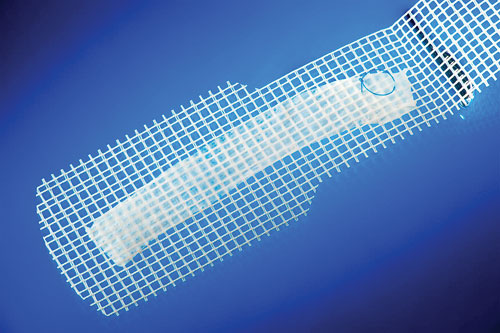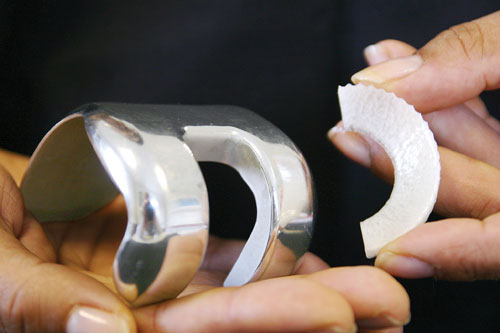November 15, 2012 (Vol. 32, No. 20)
Sue Pearson Ph.D. Freelance Writer GEN
Two of the main barriers to making regenerative medicine products more widely available are high prices and the difficulty for surgeons and clinicians to implement them in their routine clinical practice, reported Nick Skaer, Ph.D., CEO of Orthox, at Regener8’s recent “Regenerative Therapies” conference in Newcastle, U.K.
“Early application and process development can greatly affect the cost of goods of these products,” added John Fisher, Ph.D., professor of mechanical engineering and director of the Institute for Medical and Biological Engineering at the University of Leeds, and executive director for Regener8.
“Currently, nobody knows how to make regenerative medicine provide economic benefit, and from the outset everyone from health economists to engineers, to scientists and clinicians, has a role to play along the innovation pathway until we get these products accepted.”
Scaling up a product for clinical use and market approval presents many technical challenges. “What works in the research lab cannot always be translated to a clinically suitable process. For example, during the production of our vascular patch, in the original research method we had used a bovine-derived nuclease and some of the buffers had BSA in them,” commented Helen Berry, Ph.D., research and technical manager of Tissue Regenix.
“When it came to developing our manufacturing process for the product to be used in the clinic, the bovine-derived nuclease was exchanged for a recombinant nuclease and the BSA was removed from the buffer to avoid the risks associated with using some bovine-derived reagents,” she explained.
“How you are going to use the product in product-development studies has to directly relate to clinical practice,” Dr. Berry added. “In our preclinical trials, the sutures used to attach our vascular patch product in the veterinary situation were different to those sutures used in humans, but clinical advice was sought on this prior to the start of the study to confirm that they were still relevant.
“In short, if you are a small medical technology company looking to design a regenerative therapy as a medical device, you should identify the clinical application as early as possible and use information on this to aid in the design of the production process and end-product. Also, seek help from established testing houses because they may identify areas that the regulators will want to know about that you may not have even considered.”
From the clinician’s point of view, Jason Wong, M.D., Ph.D., clinical lecturer in plastic and reconstructive surgery, School of Medicine, University of Manchester, explained why large numbers of regenerative medicine technologies are not being widely used.
“Hurdles exist at the developmental, pre-clinical, and, ultimately, clinical level, and it is very easy to stumble at any one of these if you do not understand the clinical application clearly. Basic scientists should really collaborate with clinicians early, at the developmental stage and throughout the development of such a project to ensure clinical translation has the slightest hope of becoming a reality.”
Silky Smooth Knees
Despite the obstacles surrounding commercializing regenerative medicine, the conference showcased technologies using inexpensive biomaterials as platforms for cell growth. One example is the FibroFix™ silk-protein based tissue scaffold from Orthox.
“Spider silk is very strong but is only available in small quantities,” explained Dr. Skaer. “Silk from the silk worm is plentiful and inexpensive to manufacture, yet it is not as tough because spider silk is spun in a different way. We strip off the outer layer of silkworm silk fibers leaving the fibroin protein core. We then process this silk fibroin into knee cartilage implants in a way that mimics how a spider spins its silk into a highly ordered structure. Therefore, our processed silkworm fibroin that we use to make our FibroFix implants captures the toughness found in spider silk.”
The company currently has two implants in development, and the lead product FibroFix Meniscus is designed to repair and regenerate the meniscal cartilage in the knee. “The meniscus is the shock absorber of the knee,” Dr. Skaer said. “In a lifetime it will undergo millions of cycles, which means it is often injured and degenerates with time.
“The meniscus has poor blood supply so current treatment for meniscal injury is to remove the damaged meniscal tissue in a meniscectomy operation. Around 60,000 of these operations are performed in the U.K. each year and 1.7 million per year world-wide. Unfortunately, this operation can lead to subsequent deterioration of the knee cartilage, eventually resulting in the painful condition osteoarthritis.”
According to Dr. Skaer, FibroFix Meniscus will be used to replace the tissue removed in a meniscectomy procedure and is introduced into the knee through the same key-hole incision used to perform the meniscectomy. This minimizes operating time, and the great mechanical strength of the implant offers the potential for rapid patient rehabilitation, according to Dr. Skaer.
Once fixed in place, the company claims the implant should be strong enough to assume the role of the removed meniscal tissue, and because it is porous will allow new tissue deposition and growth of blood vessels into the body of the implant, enabling a longer-term repair.
“When implanted into the knee there is the potential for porous scaffolds to act like a cheese grater and wear away the cartilage because they don’t have smooth surfaces,” Dr. Skaer commented. “Since our implant has smooth surfaces integrated with its porous structure, it should be less likely to do this.”
To date the company has mechanically tested the FibroFix Meniscus in over 15 million load cycles, which is the equivalent to around 10 years of wear in a patients knee. The product has been tested by surgeons in cadaver experiments and they have found it takes around 15–20 minutes to implant. The product has also been used in preclinical trials with sheep, where it has shown that it supports cell ingress and growth of neocartilage tissue from progenitor cells and the deposition of aligned collagen.
“The raw materials to manufacture our products are inexpensive, and using an established aseptic manufacturing process we can make FibroFix Meniscus in-house for a very low cost,” Dr. Skaer stated. “We are positive about the future and aim to go into clinical trials with FibroFix Meniscus next year and also to look at other areas where FibroFix technology could be used for cartilage repair.”

FibroFix™ Meniscus (right) is a tissue regenerative implant that could lead to fewer knee replacement prostheses (left) in the future, according to Orthox.
Collagen—A Wonder Material?
Another technology that uses inexpensive material as a cellular growth platform is the dCELL® Vascular Patch from Tissue Regenix.
“The dCELL vascular patch is a scaffold made from porcine pericardium,” Dr. Berry explained. “The pericardium is treated in our dCELL process, with a series of solutions to remove cellular material from the tissue to leave a collagen matrix, which maintains the structural and biomechanical properties of the native tissue. The resulting scaffold is acellular and immunocompatible. This is then grafted onto a patient’s damaged arteries where it becomes repopulated with the patient’s own cells, leading to self-regeneration of the artery without having any immune rejection problems.”
The firm has just completed a two-year post-marketing study of 21 patients who all had an artery treated with the patch because they suffered with peripheral vascular disease and had surgery to remove a blood vessel blockage. The study showed that it was difficult or impossible to distinguish the location of the dCELL vascular patch on the repaired artery, which suggests it has been integrated into the patients’ own artery. These results indicate that it may be possible to deliver regenerative medicines that are safe and effective at a potentially affordable cost.
Another promising use of collagen as a regenerative medicine platform was discussed by Julie Daniels, Ph.D., professor of regenerative medicine and cellular therapy at University College London (UCL). “10 million people worldwide suffer from a disease or injury of the cornea, which blinds them and can only be treated by corneal transplant,” she said. “As there is not enough corneal tissue available to meet this need, tissue engineering could provide a solution.
“As a first step, we have used human amniotic membrane and seeded it with limbal stem cells—a cell type that maintains the outer epithelium of the cornea—and used this to treat patients with blinding ocular surface disease.”
Using this method, Dr. Daniels’ group has treated 25 patients, and 60% of these patients have experienced improved vision. “Amnion is biologically variable in its ability to support cultured limbal stem cells. We have had a 30 percent culture failure rate for these types of corneal transplants, which we felt was unacceptable.”
The group has now developed a collagen-based hydrogel as the cell seeding platform and, using a technique developed at UCL, has been able to emboss limbal stem cells that remain viable onto the collagen.
“We are now using our new type of biomimetic corneal tissue in proof of concept animal studies and hope to begin our first-in-man studies with patients in the next year,” Dr. Daniels concluded.

The dCELL® Vascular Patch from Tissue Regenix is a thin, strong, and flexible porcine pericardium patch.



